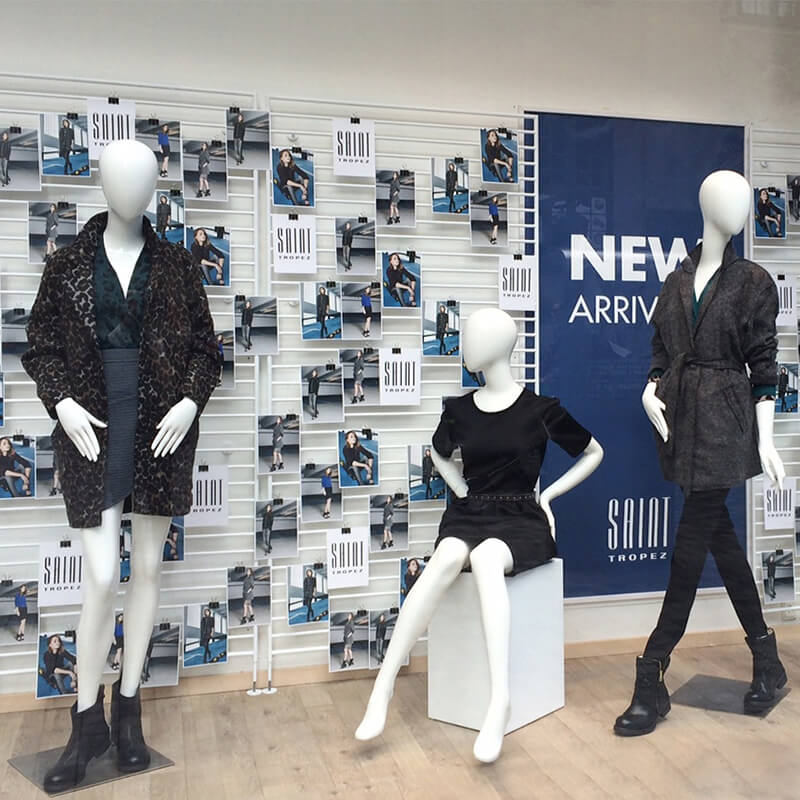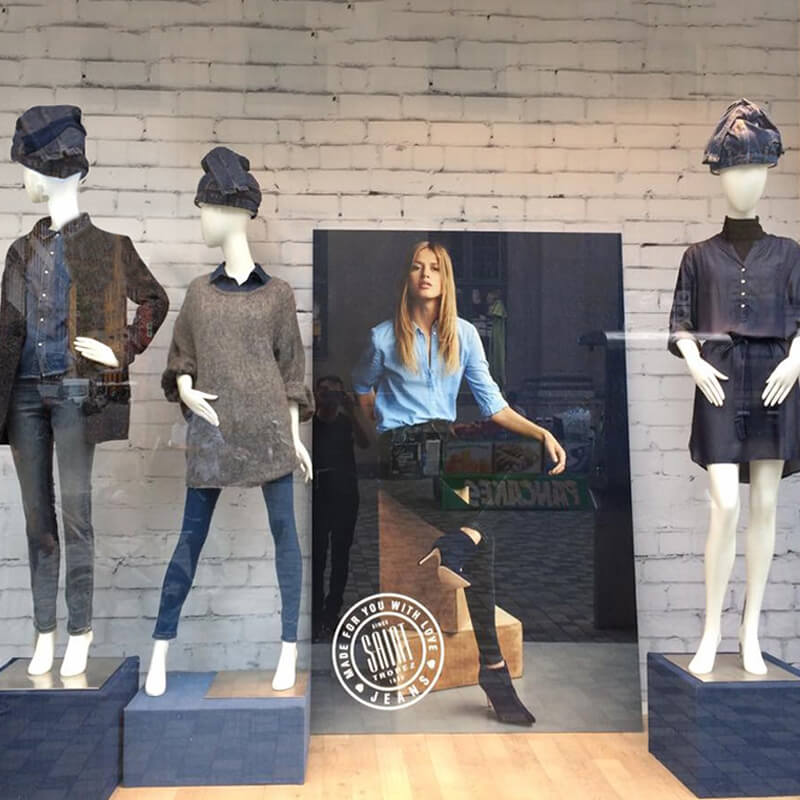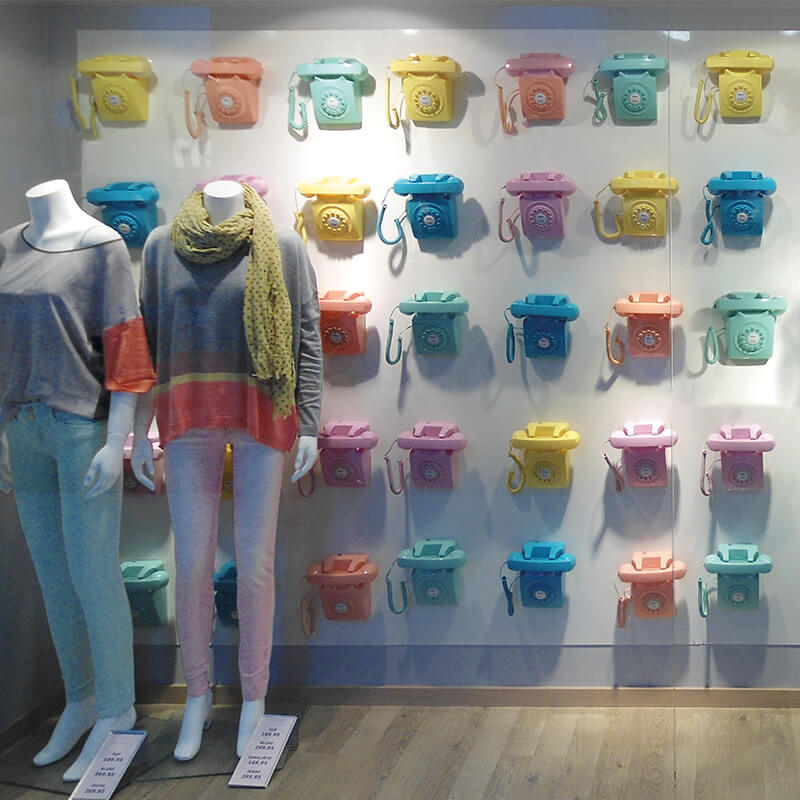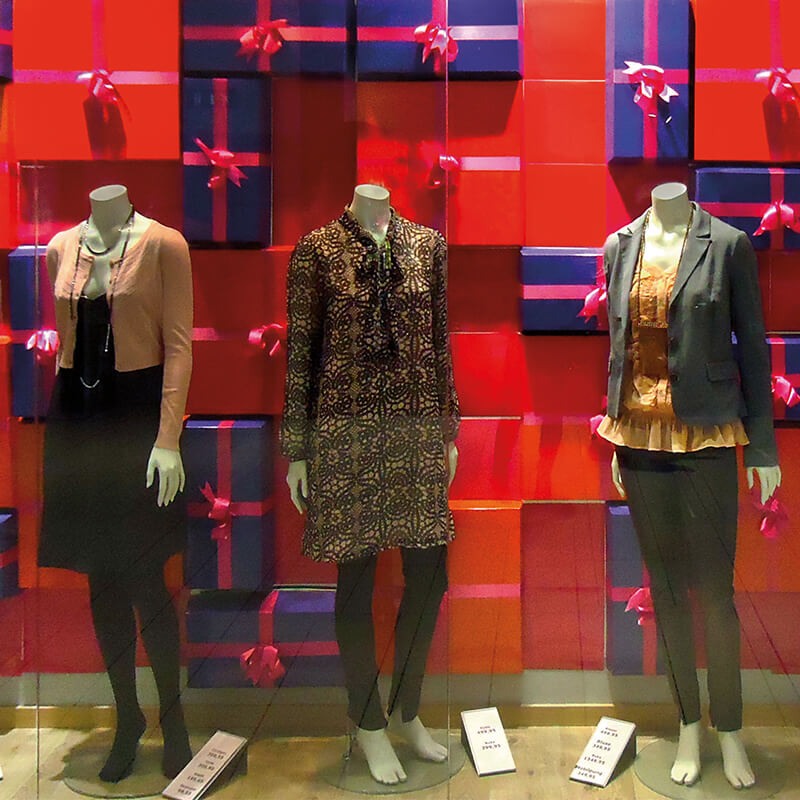Saint Tropez
Saint Tropez’s strategic and cost-effective visual merchandising set-up
Saint Tropez was first established in 1986 and is one of Denmark’s most popular women’s clothing brands. The mid-range brand is sold all over Northern Europe and creates dynamic and trendy clothing for the modern woman.
Saint Tropez’s visual merchandising department is smaller than the average brand and is made up of a one-man army. A single VM Manager who is responsible for the full visual merchandising of all stores and has a wide range of related responsibilities, including the development of all seasonal campaigns.
We have had a strong relationship with Saint Tropez and worked together since 2010 on a large number of projects


effective, but economical, VM campaigns
Saint Tropez’s business set-up, conscious VM budget, and mid-range positioning within the women’s fashion industry offered a couple of challenges when it came to developing VM.
1. Creating campaigns with consideration of budget
The brand wanted to get the most value for their money whilst creating impactful campaigns for their windows that still looked professional and grabbed their customers’ attention.
But, for each campaign, there needed to be a significant consideration for the economic aspect, and these boundaries had to be respected.
There needed to be a solution that would offer the brand a complete economical approach to VM, give the desired appearance and illusion, but without the need for heavy investment.
2. One-stop-shop execution partner
Due to the brand’s VM Manager’s extensive role, there needed to be a solution that involved an experienced execution partner. A partner that could easily undertake the grand scale and responsibilities and tasks associated with visual merchandising.
There was a need for a partner to take a simple brief, created by the VM Manager, consisting of a photo or similar idea for inspiration, and execute it through all the process steps to the final product.
The only involvement that the VM Manager should have in the campaign’s further development would be to make the key decisions and focus on other responsibilities and tasks.
We suggested two strategic initiatives
To achieve impactful campaigns with consideration for the budget, we suggested two strategic initiatives:
1. Development of a generic system for VM campaigns
We strategically approached the brand’s VM challenge by developing a generic system of “building blocks” that could be incorporated into the solution of the individual campaigns when needed. This system consisted of 5 elements:
- The wall metal sheets allowed for a simple and easy way to hang different elements for each campaign. Any element could be mounted onto the wall by the use of magnets. An example of this was the Pom-pom campaign, where the pom-poms were made from yarn and had magnets attached to the back that were easily mounted to the wall metal sheets.
- The image frame profiles were made using built-in magnets and were re-used multiple times for displaying changeable posters on top of the wall metal sheets. These image frame profiles were created in classic black and white colours, and this offered the brand to choose the best matching option. The image frame profiles were used across most campaigns.
- The display racks were used to hang different elements and acted as a straightforward way to change up each campaign. For instance, in Saint Tropez’s postcard campaign, where different, colourful postcards were displayed to create an impactful window backdrop.
- The podium set was used to elevate the mannequins and give the brand the option of including height variations. This was useful when the brand wanted to change the look of their windows. These podiums were also completely removable if needed. The podium set was also a changeable component, where covers could change the appearance entirely. An example of this is the jeans campaign, where these covers were sewn from denim to give the podium set a look that matched the theme of the campaign.
- The mannequin headgear offered Saint Tropez a simple, yet impactful, way to create interest and focus on their windows. An elastic fabric band was attached around the head of the mannequins allowing for replaceable signs to be attached with velcro. This element allowed the brand to thoroughly switch up the look and the message of the window. An example of this is the SALE campaign, where the head signs communicated the sale in a powerful and eye-catching way.
With the generic framework, the brand had the means to create easily changeable campaigns. The five available “building blocks” became the skeleton framework for Saint Tropez to simply convert the look and appearance of their VM.
This approach also proved the most economical, for a number of reasons:
- The components could be re-used repeatedly, plus be inexpensively transformed to give a whole new appearance
- There was a reduced requirement for the number of fully new components to be produced for each campaign, which saved on manufacturing costs
- The accessories used to change the appearance of these components (e.g. the denim podium covers) occupy less volume and weigh less than a full podium would, and therefore transport costs were reduced
- From a design and development point of view, the concepts were based on the given conditions that were already in place, saving time and resources on conceptual development.
Together, all of the above factors created a very cost-effective and versatile system for Saint Tropez’s visual merchandise displays, which matched perfectly with the brand’s conscious budget strategy.




2. Following strategic principles
To overcome the economic challenges, we came up with strategic approaches, which stretched the furthest, but still accommodated the desired appearance and look that Saint Tropez wanted:
- The use of standard products
The elements initially sourced were typically standard items that were then customised to some extent. This would transform the standard element to match the desired look for the campaign without the cost of a 100% fully customised element, which would be expensive to execute. For example, in the case of the telephones, they were standard telephones that were cast in specific colours to match the window expression. - Repetition and scale of economy
To meet the brand’s conscious budget, few elements were utilised, but in larger quantities to take advantage of the scale of the economy. For example, the sunflowers, which were all produced in the same materials, colours and shape, and only in two sizes. - Cost-effective materials
Additionally, we used the most cost-effective material option, which would still achieve the desired look. For example using materials such as silver paper for the mannequin’s head piece rather than metal, which would have cost more but achieved a similar result. - Reduce volume – transportation cost
To keep transportation costs low, there was large consideration towards the optimisation of the volume already during the development phase. For instance, the Christmas gift boxes were made in a cone-like shape to utilise strategic stacking to reduce volume during transportation, which therefore reduced costs. - General quality level
The brand’s market positioning, combined with the fashion segment, where there is a larger viewing distance, and therefore a larger tolerance for possible variances, allowed for the acceptance of tolerances to a larger extent. This reduced waste during production. The general quality level was specified to our production partners, which allowed us to further optimise the budget. - In-store installation
The repeated use of the generic system elements combined with detailed and easy to understand assembly guidelines allowed for quick and simple installation, carried out by the in-store staff. This approach reduced costs even further by eliminating the potential need for an external contractor to install the VM, which can be costly.




Saint Tropez works with us on 6-8 campaigns per year
With this set-up, Saint Tropez works with us on 6-8 campaigns per year. This optimised and efficient framework makes it easy for the brand to display impactful and effective campaigns whilst remaining economical.
The generic system has formed the foundation for the brand’s campaigns, which has resulted in eye-catching displays with a versatile base whilst making full use of the brand’s resources.
Cost philosophy
For brands to achieve 100% flawless, perfect VM, there is a general philosophy seen when obtaining this high level of quality.
The initial 80% of the appearance and quality level is easy and relatively cheap to achieve, in some cases costing only 20% of the budget.
However, the remaining 20% of the appearance and quality level is the most expensive and can use up to 80% of the budget, which is used to reach absolute perfection.
This theory is obviously generalised, and the ratio can vary for all cases. However, it expresses the principles of the philosophy that is strategically applied in our collaboration with Saint Tropez when creating their seasonal campaigns.
Do you want to hear more about how we can help you create cost-effective VM campaigns?
Cases
More case studies
Receive our portfolio
Our work includes custom-made visual merchandising campaigns, for both window and in-store use – for a wide range of well-known retail brands.
